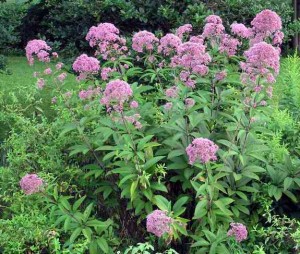(Quenn of the meadow)--(Eupatorium purpureum)
Native Americans have used gravel root to treat health problems for centuries. This herb was once instrumental in treating the disease typhus. In fact, the name "Joe Pye Weed" comes from this use by a Native American who used it to treat settlers in the New England area.
 |
| The leaves and flowering stems are harvested in the summer before the buds open and are dried for later use.The roots are harvested in the autumn and dried for later use. |
 |
Gravel root, c/s, wild crafted |
Part used: root.
Properties: diuretic, lithotriptic, astringent, nervine, stimulant,
What it affects: kidneys, bladder, nerves and joints.
Preparation and amount:
Infusion (herb): steep5-15 min and take 1-2 cups daily.
Decoction (root): Simmer 6-15 min and drink1-2 oz. as needed up to 2 cups daily
Tincture: drink 30-60 drops( 1/2-1 tsp) 3 x a day.
Fluid extract. drink 1/2-1 tsp. 3 x a day.
Powder: 5 #0 capsules (30 grains) 3 x a day.
Purposes:
Internally, gravel root is one of the great remedies for gravel and stones in the kidneys and bladder. It is also used to treat the uric acid deposits in joints,which make them so painful. It also works to reduce water retention and deal with prostate disorders. A strong decoction is used: 1 oz. of the root boiled in a pint of water for one hour then take a quarter cup at a time as needed. When using a tincture, take 1 tsp. at a time.
In addition, gravel root is a nerve tonic and used for many female problems, alone or in combination. This includes dysmenorrhea, endometritis, leukorrhea, chronic uterine disease, labor pains and threatened abortions. Gravel roots is also used for cystitis, edema, gout, rheumatism, weak pelvic organs, gonorrhea, cystitis, bright's disease, bloody urine, and backache.
Plant Description:
| The stem is rigidly erect, usually about 5 or 6 feet high, though sometimes even reaching a height of 12 feet, and is stout, unbranched and either hollow, or furnished with an incomplete pith. It's purple flower above the joints and often covered with elongated spots and lines (this variety having been called maculata by Linnaeus). The leaves, oblong and pointed, rough above, but downy beneath, are placed in whorls of four or five on the stem (mostly in fives) and are nearly destitute of resinous dots. The margins are coarsely and unequally toothed, the leafstalks either short or merely represented by the contracted bases of the leaves. The flowers are purple, in a dense terminal inflorescence, the heads very numerous, five to ten flowered, contained in an eight-leaved, fresh-coloured involucre. |
Fantastic Post! Lot of information is helpful in some or the other way. Keep updating gravel root powder
ReplyDelete